Controls of Climate and Land-Use Change on Terrestrial Net Primary Productivity Variation in a Subtropical Humid Basin
Abstract
:1. Introduction
2. Material and Methods
2.1. Study Area
2.2. Available Data
2.3. Methodology
2.3.1. CASA Model
2.3.2. Linear Regression Analysis
2.3.3. Correlation Analysis
2.3.4. Estimation of the Impacts of Climate and Land Use Changes
3. Results
3.1. Changes of NPP
3.2. Changes of Land Use and Npp in Two Different Periods
3.3. Correlations between NPP and Meteorological Factors
3.4. Controls of Climate and Land Use Change on TP
4. Discussion
4.1. About the Verification of CASA Model
4.2. Impact of Climate Change on NPP
4.3. Impact of Human Activities on NPP
5. Conclusions
Author Contributions
Funding
Conflicts of Interest
References
- Zhao, M.; Running, S.W. Drought-induced reduction in global terrestrial net primary production from 2000 through 2009. Science 2010, 329, 940–943. [Google Scholar] [CrossRef] [PubMed] [Green Version]
- Suzuki, R.; Masuda, K.; Dye, D.G. Interannual covariability between actual evapotranspiration and PAL and GIMMS NDVIs of northern Asia. Remote. Sens. Environ. 2007, 106, 387–398. [Google Scholar] [CrossRef]
- Tong, X.; Wang, K.; Brandt, M.; Yue, Y.; Liao, C.; Fensholt, R. Assessing future vegetation trends and restoration prospects in the Karst Regions of Southwest China. Remote. Sens. 2016, 8, 357. [Google Scholar] [CrossRef] [Green Version]
- Intergovernmental Panel on Climate Change (IPCC). Climate change 2001: The Scientific Basis. In Contribution of Working Group I to the Third Assessment Report of the IPCC; Houghton, J.T., Ding, Y., Griggs, D.J., Noguer, M., Vander Linden, P.J., Xiaosu, D., Eds.; Cambridge University Press: Cambridge, UK, 2001. [Google Scholar]
- Cao, M.; Woodward, F.I. Dynamic responses of terrestrial ecosystem carbon cycling to global climate change. Nature 1998, 393, 249–252. [Google Scholar] [CrossRef]
- Walther, G.R.; Post, E.; Convey, P.; Menzel, A.; Parmesan, C.; Beebee, T.J.; Fromentin, J.M.; Hoeghguldberg, O.; Bairlein, F. Ecological responses to recent climate change. Nature 2002, 416, 389–395. [Google Scholar] [CrossRef] [PubMed]
- Tao, B.; Li, K.R.; Shao, X.M.; Cao, M.K. Temporal and Spatial Pattern of Net Primary Production of Terrestrial Ecosystems in China. Acta Geogr. Sin. 2003, 58, 372–380. [Google Scholar]
- Eugster, W.; Rouse, W.R.; Pielke, R.A., Sr.; Mcfadden, J.P.; Baldocchi, D.D.; Kittel, T.G.F.; Chapin, F.S.; Liston, G.E.; Vidale, P.L.; Vaganov, E. Land-atmosphere energy exchange in Arctic tundra and boreal forest: Available data and feedbacks to climate. Glob. Chang. Biol. 2000, 6, 84–115. [Google Scholar] [CrossRef]
- Lobell, D.B.; Hicke, J.A.; Asner, G.P.; Field, C.B.; Tucker, C.J.; Loss, S.O. Satellite estimates of productivity and light use efficiency in United States agriculture, 1982–1998. Glob. Chang. Biol. 2002, 8, 722–735. [Google Scholar] [CrossRef]
- Jiang, H.L.; Xu, X.; Guan, M.X.; Wang, L.F.; Huang, Y.M.; Jiang, Y. Determining the contributions of climate change and human activities to vegetation dynamics in agro-pastural transitional zone of northern China. Sci. Total Environ. 2020, 718, 134871. [Google Scholar] [CrossRef]
- Arora, V. Modeling vegetation as a dynamic component in soil-vegetation-atmosphere transfer schemes and hydrological models. Rev. Geophys. 2008, 40, 1–3. [Google Scholar] [CrossRef] [Green Version]
- McLaughlin, D.; Cohen, M.J. Realizing ecosystem service: Wetland hydrologic function along a gradient of ecosystem condition. Ecol. Appl. 2013, 23, 1619–1631. [Google Scholar] [CrossRef] [PubMed]
- Zhao, X.; Zhou, W.Z.; Tian, L.; He, W.H.; Zhang, J.C.; Liu, D.H.; Yang, F. Effects of land-use changes on vegetation net primary productivity in the Three Gorges reservoir Area of Chongqing. Acta Ecol. Sin. 2018, 38, 7658–7668. (In Chinese) [Google Scholar]
- Zhu, Y.G.; Du, L.T.; Xie, Y.Z.; Liu, K.; Gong, F.; Dan, Y.; Wang, L.; Zheng, Q.Q. Spatiotemporal characteristics of grassland net primary production in Ningxia Province from 2000 to 2015 and its response to climate change. Acta Ecol. Sin. 2019, 39, 518–529. (In Chinese) [Google Scholar]
- Gower, S.T.; Krankina, O.; Olson, R.J.; Apps, M.; Linder, S.; Wang, C. Net primary production and carbon allocation patterns of boreal forest ecosystems: Global analysis of environmental and land use change effects. Ecol. Appl. 2001, 11, 1395–1411. [Google Scholar] [CrossRef]
- Mu, S.J.; Li, J.L.; Yang, H.F.; Gang, C.C.; Chen, Y.Z. Spatio-temporal variation analysis of grassland net primary productivity and its relationship with climate over the past 10 years in Inner Mongolia. Acta Pratacult. Sin. 2013, 22, 6–15. (In Chinese) [Google Scholar]
- Piao, S.L.; Fang, J.Y.; Guo, Q.H. Application of CASA model to the estimation of Chinese terrestrial net primary productivity. Acta Phytoecol. Sin. 2001, 25, 603–608. (In Chinese) [Google Scholar]
- Goroshi, S.; Pradhan, R.; Singh, R.P.; Parihar, J.S. Revisiting CASA ecosystem model for Global NPP study: A new perspective. In Proceedings of the National Climate Science Conference, Paris, France, 30 November–12 December 2015. [Google Scholar]
- Ye, X.; Meng, Y.; Xu, L.; Xu, C. Net primary productivity dynamics and associated hydrological driving factors in the floodplain wetland of China’s largest freshwater lake. Sci. Total Environ. 2019, 659, 302–313. [Google Scholar] [CrossRef]
- Zhu, W.Q.; Pan, Y.Z.; Zhang, J.S. Estimation of net primary productivity of Chinese terrestrial vegetation based on remote sensing. J. Plant Ecol. 2007, 31, 413–424. [Google Scholar]
- Nemani, R.R.; Keeling, C.D.; Hashimoto, H.; Jolly, W.M.; Piper, S.C.; Tucker, C.J.; Myneni, R.B.; Running, S.W. Climate-driven increases in global terrestrial net primary production from 1982 to 1999. Science 2003, 300, 1560–1563. [Google Scholar] [CrossRef] [Green Version]
- Qu, S.; Wang, L.C.; Lin, A.W.; Zhu, H.J.; Yuan, M.X. What drives the vegetation restoration in Yangtze River basin, China: Climate change or anthropogenic factors? Ecol. Indic. 2018, 90, 438–450. [Google Scholar] [CrossRef]
- Yao, R.; Wang, L.; Gui, X.; Zheng, Y.; Zhang, H.; Huang, X. Urbanization effects on vegetation and surface urban heat Islands in China’s Yangtze River Basin. Remote. Sens. 2017, 9, 540. [Google Scholar] [CrossRef] [Green Version]
- De Jong, R.; Schaepman, M.E.; Furrer, R.; De Bruin, S.; Verburg, P.H. Spatial relationship between climatologies and changes in global vegetation activity. Glob. Chang. Biol. 2013, 19, 1953–1964. [Google Scholar] [CrossRef] [PubMed]
- Chen, F.; Li, H.B.; Liu, Y.J. Spatio-temporal differentiation and influencing factors of vegetation net primary productivity using GIS and CASA: A case study in Yuanyang County, Yunnan. Chin. J. Ecol. 2018, 37, 2148–2158. (In Chinese) [Google Scholar]
- Liu, Y.B.; Ju, W.M.; He, H.L.; Wang, S.; Sun, R.; Zhang, Y. Changes of net primary productivity in China during recent 11 years detected using an ecological model driven by MODIS data. Front. Earth Sci. 2013, 7, 112–127. [Google Scholar] [CrossRef]
- Miao, Q.; Huang, M.; Li, R.Q. The Impacts of Climate Change on Vegetation Net Primary Productivity of the Yangtze River Basin. J. Nat. Resour. 2010, 25, 1296–1305. (In Chinese) [Google Scholar]
- Chen, C.; Park, T.; Wang, X.; Piao, S.; Xu, B.; Chaturvedi, R.K.; Fuchs, R.; Brovkin, V.; Ciais, P.; Fensholt, R. Others China and India lead in greening of the world through land-use management. Nat. Sustain. 2019, 2, 122–129. [Google Scholar] [CrossRef]
- Yu, K.; Hu, C. Changes in vegetative coverage of the Hongze Lake national wetland nature reserve: A decade-long assessment using MODIS medium-resolution data. J. Appl. Remote. Sens. 2013, 7, 302–313. [Google Scholar] [CrossRef] [Green Version]
- Xu, G.; Zhang, H.; Chen, B.; Zhang, H.; Innes, J.L.; Wang, G.; Yan, J.; Zheng, Y.; Zhu, Z.; Myneni, R.B. Changes in vegetation growth dynamics and relations with climate over China’s Landmass from 1982 to 2011. Remote. Sens. 2014, 6, 3263–3283. [Google Scholar] [CrossRef] [Green Version]
- Austin, A.T.; Vivanco, L.I.A. Plant litter decomposition in a semi-arid ecosystem controlled by photo degradation. Nature 2006, 442, 555–558. [Google Scholar] [CrossRef]
- O’Connor, T.G.; Haines, L.M.; Snyman, H.A. Influence of precipitation and species composition on phytomass of a semi-arid African grassland. J. Ecol. 2001, 89, 850–860. [Google Scholar] [CrossRef]
- Bai, Y.F.; Li, L.H.; Wang, Q.B.; Zhang, L.X.; Zhang, Y.; Chen, Z.Z. Changes in plant species diversity and productivity along gradients of precipitation and elevation in the Xilin river basin, inner Mongolia. Acta Phvtoecolottica Sin. 2000, 24, 667–673. (In Chinese) [Google Scholar]
- Chiew, F.H.S.; Whellon, P.H.; Memahon, T.A.; Pittock, A.B. Simulation of the impacts of climate change on runoff and soil moisture in Australian catchments. J. Hydrol. 1995, 167, 121–147. [Google Scholar] [CrossRef]
- Schreider, S.Y.; Jakemen, A.L.; Pittock, A.B.; Whetton, P.H. Estimation of possible climate change impacts on water availability, extreme flow event and soil moisture in Goulburn end Oven basins, Victoria. Clim. Chang. 1996, 34, 513–546. [Google Scholar] [CrossRef]
- DeFries, R.S.; Field, C.B.; Fung, I.; Collatz, G.J.; Bounoua, L. Combining satellite data and biogeochemical models to estimate global effects of human induced land cover change on carbon emissions and primary productivity. Glob. Biogeochem. 1999, 13, 803–815. [Google Scholar] [CrossRef]
- Imhoff, M.L.; Bounoua, L.; DeFries, R.; Lawrence, W.T.; Stutzer, D.; Tucker, C.J.; Ricketts, T. The consequences of urban land transformation on net primary productivity in the United States. Remote. Sens. Environ. 2004, 89, 434–443. [Google Scholar] [CrossRef]
- Wu, S.H.; Zhou, S.L.; Chen, D.X.; Wei, Z.Q.; Dai, L.; Li, X.G. Determining the contributions of urbanisation and climate change to NPP variations over the last decade in the Yangtze River Delta, China. Sci. Total Environ. 2014, 472, 397–406. [Google Scholar] [CrossRef]
- Jiang, C.; Wu, Z.F.; Cheng, J.; Li, S.Y.; Liu, Q. Relative Effects of Climatic Fluctuation and Land Cover Changes on Net Primary Productivity of Vegetation in Guangdong Province. J. Trop. Subtrop. Bot. 2016, 24, 397–405. (In Chinese) [Google Scholar]
- Xu, X.B.; Tan, Y.; Yang, G.S.; Li, H.P.; Su, W.Z. Impacts of China’s Three Gorges Dam Project on net primary productivity in the reservoir area. Sci. Total Environ. 2011, 409, 4656–4662. [Google Scholar] [CrossRef]
- Piao, S.L.; Yin, G.; Tan, J.; Cheng, L.; Huang, M.; Li, Y.; Liu, R.; Mao, J.; Myneni, R.B.; Peng, S. Detection and attribution of vegetation greening trend in China over the last 30 years. Glob. Chang. Biol. 2015, 21, 1601–1609. [Google Scholar] [CrossRef]
- Zhu, Z.; Piao, S.; Myneni, R.B.; Huang, M.; Zeng, Z.; Canadell, J.G.; Ciais, P.; Sitch, S.; Friedlingstein, P.; Arneth, A. Greening of the Earth and its drivers. Nat. Clim. Chang. 2016, 6, 791–795. [Google Scholar] [CrossRef]
- Buyantuyev, A.; Wu, J. Urbanization alters spatiotemporal patterns of ecosystem primary production: A case study of the Phoenix metropolitan region, USA. J. Arid Environ. 2009, 73, 512–520. [Google Scholar] [CrossRef]
- Gu, L.; Chen, J.; Xu, C.; Kim, J.; Chen, H.; Xia, J.; Zhang, L. The contribution of internal climate variability to climate change impacts on droughts. Sci. Total Environ. 2019, 684, 229–246. [Google Scholar] [CrossRef]
- Li, A.; Wu, J.; Huang, J. Distinguishing between human-induced and climate driven vegetation changes: A critical application of RESTREND in Inner Mongolia. Landsc. Ecol. 2012, 27, 969–982. [Google Scholar] [CrossRef]
- Mueller, T.; Dressler, G.; Tucker, C.; Pinzon, J.; Leimgruber, P.; Dubayah, R.; Hurtt, G.; Hning-Gaese, K.B.O.; Fagan, W. Human land-use practices lead to global long-term increases in photosynthetic capacity. Remote. Sens. 2014, 6, 5717–5731. [Google Scholar] [CrossRef] [Green Version]
- Xin, Z.; Xu, J.; Zheng, W. Spatiotemporal variations of vegetation cover on the Chinese Loess Plateau (1981–2006): Impacts of climate changes and human activities. Sci. China Ser. D Earth Sci. 2008, 51, 67–78. [Google Scholar] [CrossRef]
- Evans, J.; Geerken, R. Discrimination between climate and human-induced dryland degradation. J. Arid Environ. 2004, 57, 535–554. [Google Scholar] [CrossRef]
- Miao, L.; Jiang, C.; Xue, B.; Liu, Q.; He, B.; Nath, R.; Cui, X. Vegetation dynamics and factor analysis in arid and semi-arid Inner Mongolia. Environ. Earth Sci. 2015, 73, 2343–2352. [Google Scholar] [CrossRef]
- Ye, X.C.; Zhang, Q.; Liu, J.; Li, X.; Xu, C. Distinguishing the relative impacts of climate change and human activities on variation of streamflow in the Poyang Lake catchment, China. J. Hydrol. 2013, 494, 83–95. [Google Scholar] [CrossRef]
- Zhang, X.X.; Yang, D.A. Allocation and study on global change transects in china. Quatern. Sci. 1995, 1, 43–54. (In Chinese) [Google Scholar]
- Zhang, Q.; Ye, X.; Werner, A.D.; Li, Y.; Yao, J.; Li, X.; Xu, C. An investigation of enhanced recessions in Poyang Lake: Comparison of Yangtze River and local catchment impacts. J. Hydrol. 2014, 517, 425–434. [Google Scholar] [CrossRef] [Green Version]
- Xu, Y.; Zhong, Y.X.; Feng, X.H.; Hu, L.T.; Zheng, L. Ecological risk pattern of Poyang Lake basin based on land use. Acta Ecol. Sin. 2016, 36, 7850–7857. (In Chinese) [Google Scholar]
- Zhu, W.Q.; Pan, Y.Z.; He, H.; Wang, L.; Mou, M.; Liu, J. A changing-weight filter method for reconstructing a high-quality NDVI time series to preserve the integrity of vegetation phenology. Geosci. Remote Sens. IEEE Trans. 2012, 50, 1085–1094. [Google Scholar] [CrossRef]
- Liu, J.; Kuang, W.; Zhang, Z.; Xu, X.; Qin, Y.; Ning, J.; Zhou, W.; Zhang, S.; Li, R.; Yan, C.; et al. Spatiotemporal characteristics, patterns, and causes of land-use changes in China since the late 1980s. J. Geog. Sci. 2014, 24, 195–210. [Google Scholar] [CrossRef]
- Potter, C.S.; Randerson, J.T.; Field, C.B.; Matson, P.A.; Vitousek, P.M.; Mooney, H.A.; Klooster, S.A. Terrestrial ecosystem production: A process model based on global satellite and surface data. Glob. Biogeochem. 1993, 7, 811–841. [Google Scholar] [CrossRef]
- Mann, H.B. Nonparametric Tests against Trend. Econometrica 1945, 13, 245–259. [Google Scholar] [CrossRef]
- Kendall, M.G. Rank Correlation Methods; Griffin: London, UK, 1975. [Google Scholar]
- Yuan, Q.Z.; Wu, S.H.; Zhao, D.S.; Dai, E.F.; Chen, L.; Zhang, L. Modeling net primary productivity of the terrestrial ecosystem in China from 1961 to 2005. J. Geogr. Sci. 2014, 1, 3–17. [Google Scholar] [CrossRef]
- Zhao, M.; Heinsch, F.A.; Heinsch, R.R.; Nemani, S.W. Running. Improvements of the MODIS Terrestrial Gross and Net Primary Production Global Data Set. Remote Sens. Environ. 2005, 95, 164–176. [Google Scholar] [CrossRef]
- Li, D.K.; Wang, Z. The Characteristics of NPP of Terrestrial Vegetation in China Based on MOD17A3 Data. Ecol. Environ. Sci. 2018, 27, 397–405. (In Chinese) [Google Scholar]
- Song, F.Q.; Kang, M.Y.; Chen, Y.R.; Yang, P.; Liu, Y.; Wang, Q. Estimation of vegetation net primary productivity on North Shanxi Loess Plateau. Chin. J. Ecol. 2009, 8, 2311–2318. (In Chinese) [Google Scholar]
- Xie, B.N.; Qin, Z.F.; Wang, Y.; Chang, Q.R. Spatial and temporal variation in terrestrial net primary productivity on Chinese Loess Plateau and its influential factors. Trans. Chin. Soc. Agric. Eng. 2014, 11, 252–261. (In Chinese) [Google Scholar]
- Huang, L.; Xiao, T.; Zhao, Z.; Sun, C.; Liu, J.; Shao, Q.; Fan, J.; Wang, J. Effects of grassland restoration programs on ecosystems in arid and semiarid China. J. Environ. Manag. 2013, 117, 268–275. [Google Scholar] [CrossRef]
- Metcalfe, D.B.; Meir, P.; Aragão, L.E.O.C.; Lobo-do-Vale, R.; Galbraith, D.; Fisher, R.A.; Chaves, M.M.; Maroco, J.P.; da Costa, A.C.L.; de Almeida, S.S.; et al. Shifts in plant respiration and carbon use efficiency at a large-scale drought experiment in the eastern Amazon. New Phytologist. 2010, 187, 608–621. [Google Scholar] [CrossRef] [PubMed]
- Gazol, A.; Camarero, J.J.; Vicente-Serrano, S.M.; Sánchez-Salguero, R.; Gutiérrez, E.; de Luis, M.; Sangüesa-Barreda, G.; Novak, K.; Rozas, V.; Tíscar, P.A.; et al. Forest resilience to drought varies across biomes. Glob. Chang. Biol. 2018, 24, 2143–2158. [Google Scholar] [CrossRef] [PubMed]
- Tian, Q.; Yang, S. Regional climatic response to global warming: Trends in temperature and precipitation in the Yellow, Yangtze and Pearl River basins since the 1950s. Quatern. Int. 2016, 440, 1–11. [Google Scholar] [CrossRef]
- Zhang, Y.; Xu, Y.; Dong, W.; Cao, L.; Sparrow, M. A future climate scenario of regional changes in extreme climate events over China using the PRECIS climate model. Geophys. Res. Lett. 2006, 33, L24702. [Google Scholar] [CrossRef]
- Zeng, X.; Zhou, J.; Zhai, J.; Su, B.; Xiong, M. Research on Climate Projection for the Period 2011–2050 in the Yangtze River Basin. Adv. Clim. Chang. Res. 2011, 7, 116–122. (In Chinese) [Google Scholar]
- Dai, X.Z.; Luo, B.H. From “harnessing” to “enrichment”—Research of strategic upgrading of mountain-river-lake engineering: Providing strong support for development of Changjiang Economic Zone. Yangtze River 2016, 47, 1–6. (In Chinese) [Google Scholar]
- Caspersen, J.P.; Pacala, S.W.; Jenkins, J.C.; Hurtt, G.C.; Moorcroft, P.R.; Birdsey, R.A. Contributions of Land-Use History to Carbon Accumulation in U.S. For. Sci. 2000, 290, 1148–1151. [Google Scholar] [CrossRef]
- Vleeshouwers, L.M.; Verhagen, A. Carbon emission and sequestration by agricultural land use: A model study for Europe. Glob. Chang. Biol. 2010, 8, 519–530. [Google Scholar] [CrossRef]
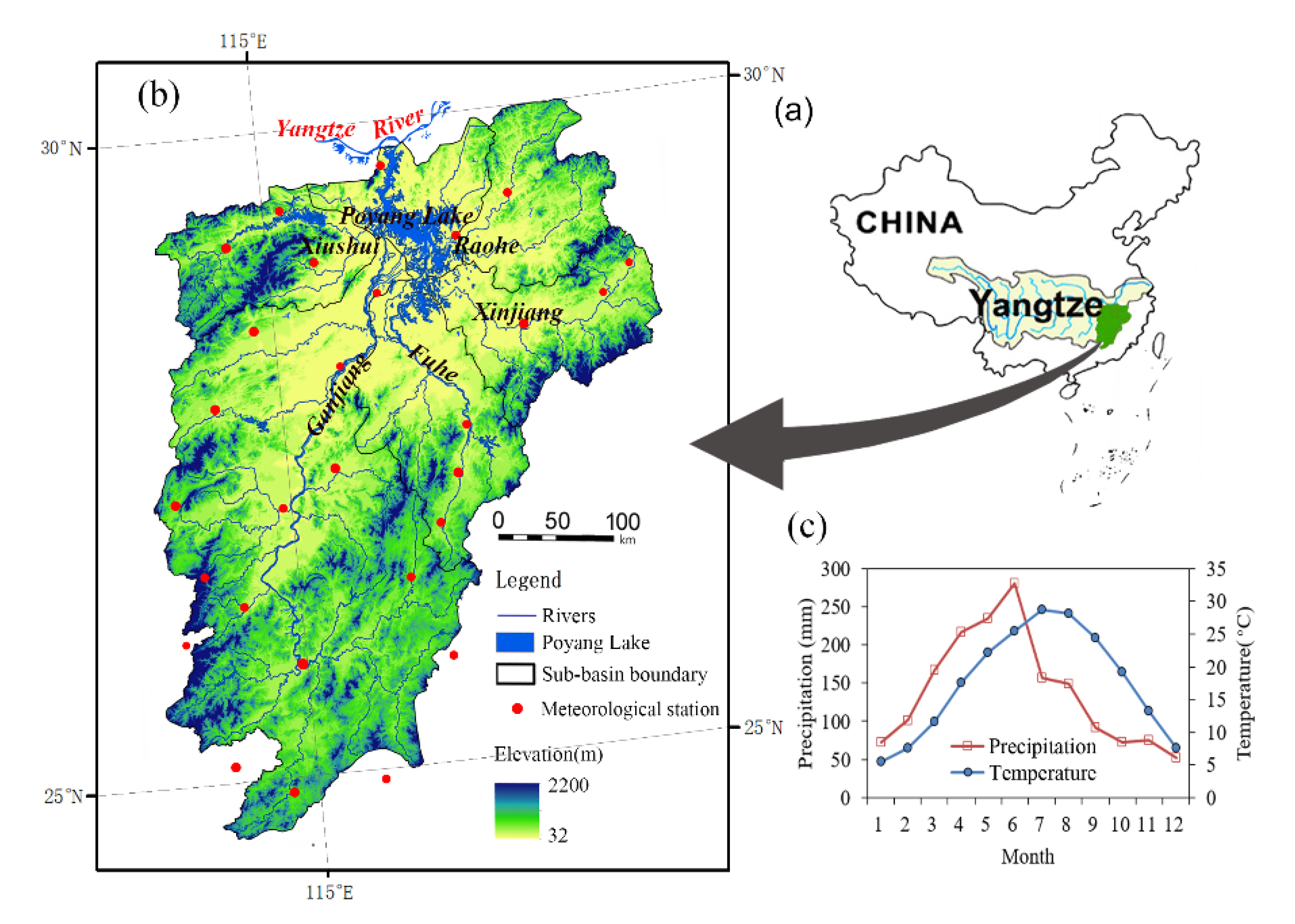




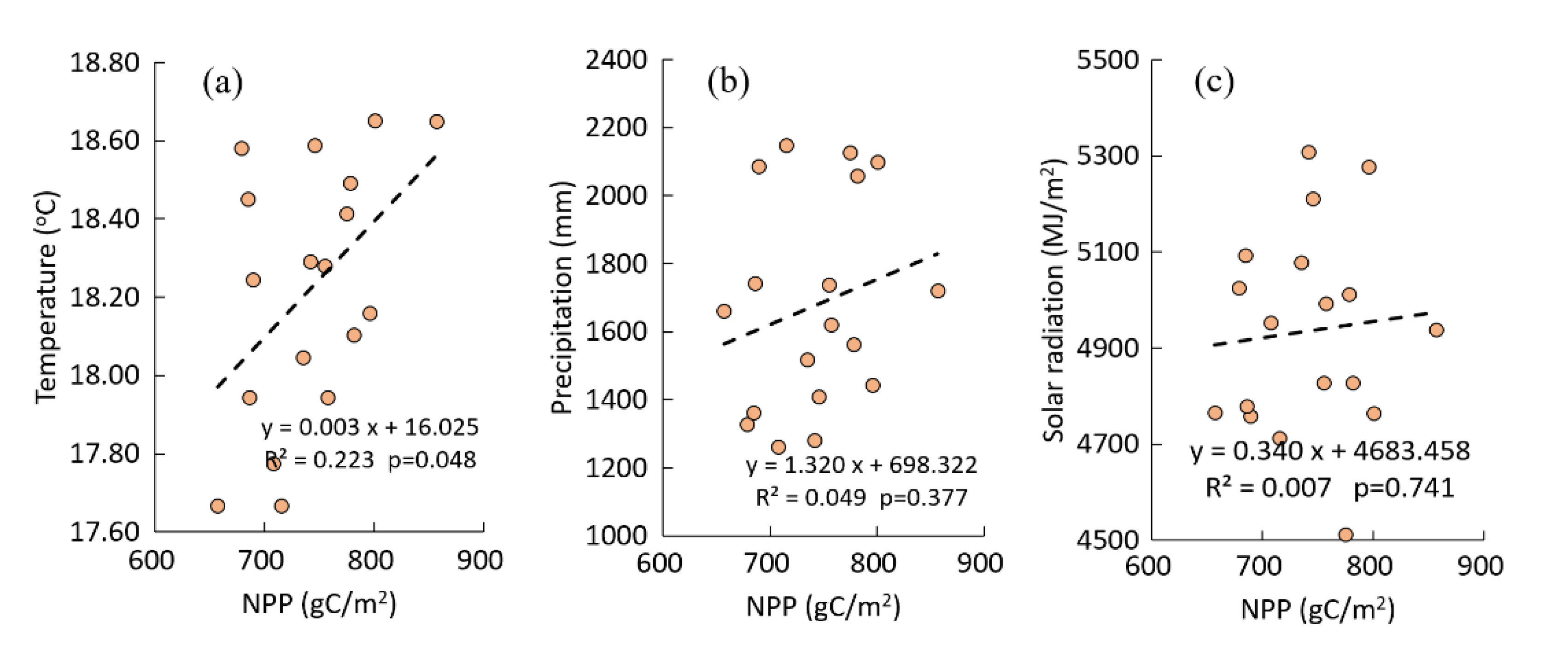
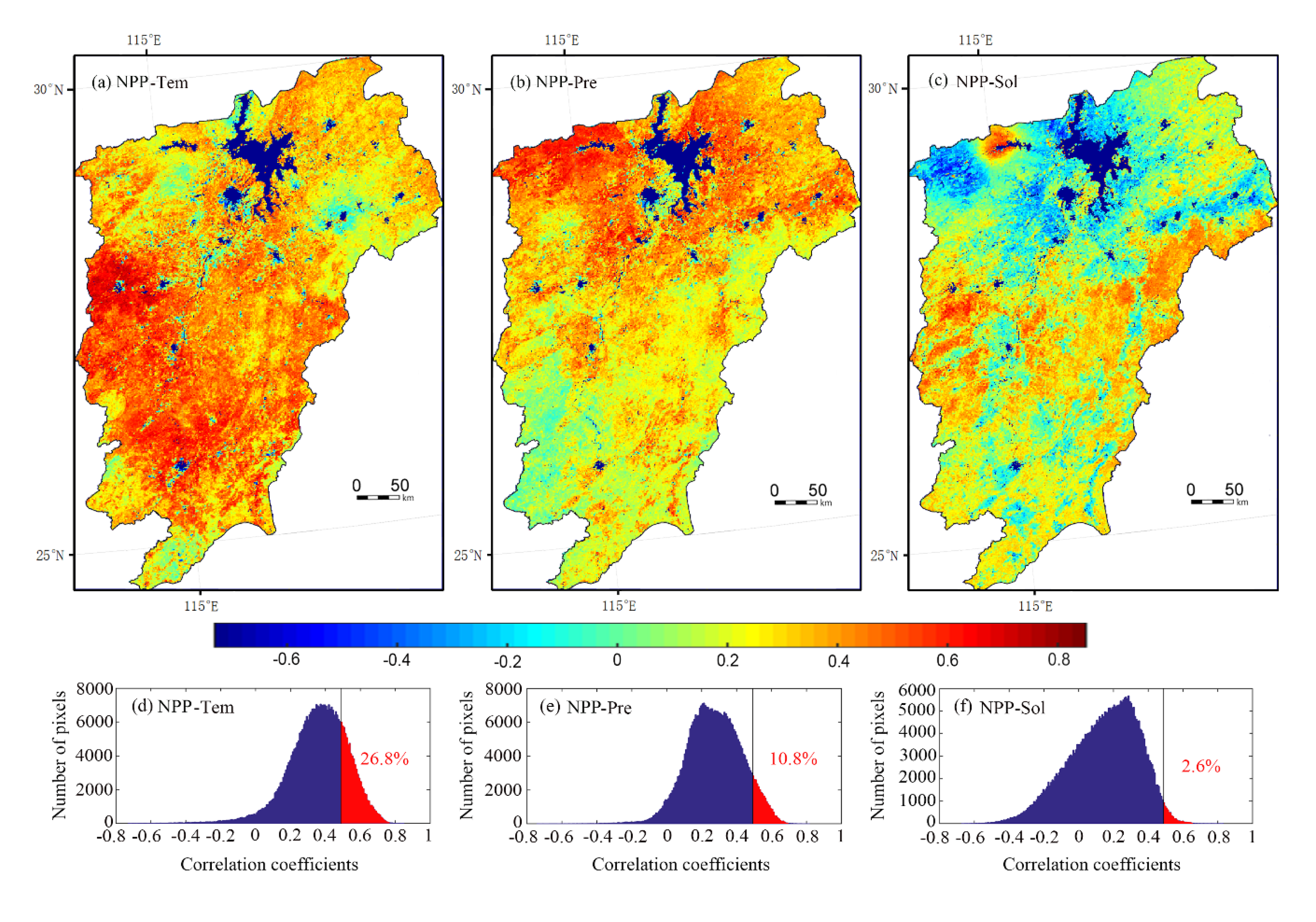

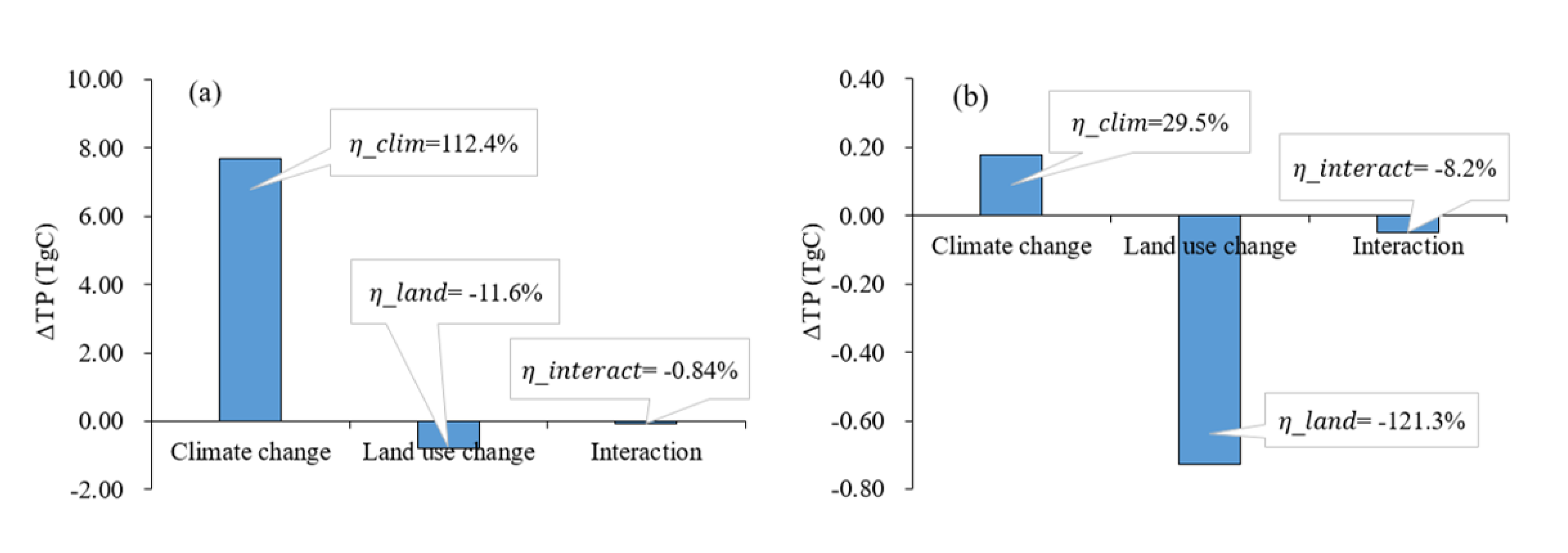
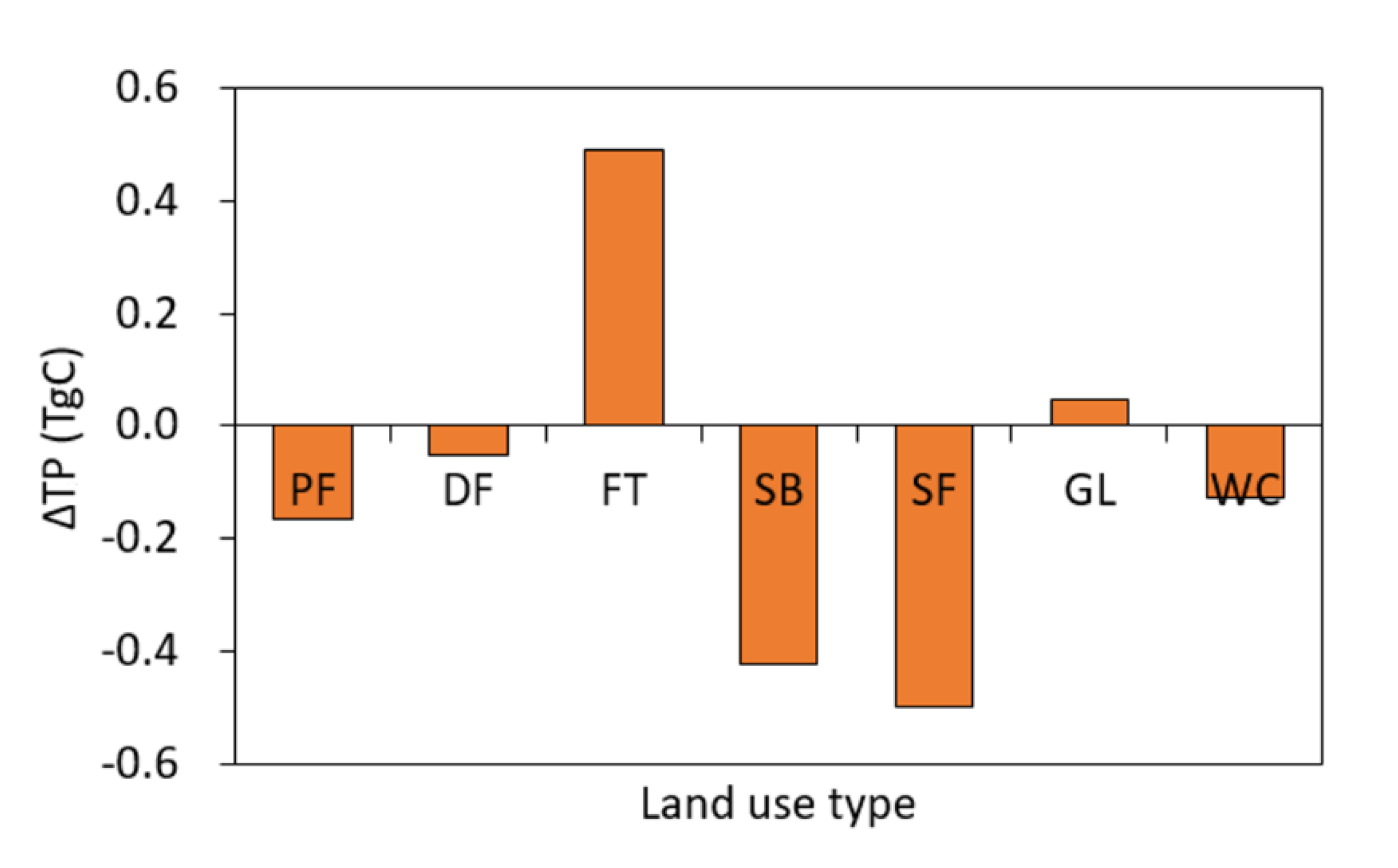
| Land Use Type | PF | DF | FT | SB | SF | GL | WC |
|---|---|---|---|---|---|---|---|
| PF | 30,463 | 27 | 54 | 3 | 36 | 5 | 588 |
| DF | 13 | 10,954 | 19 | 0 | 21 | 4 | 226 |
| FT | 56 | 63 | 67,235 | 25 | 544 | 331 | 200 |
| SB | 3 | 9 | 445 | 9043 | 25 | 18 | 38 |
| SF | 27 | 37 | 1110 | 1 | 19,255 | 51 | 207 |
| GL | 38 | 6 | 178 | 9 | 103 | 6467 | 57 |
| WC | 156 | 32 | 7 | 0 | 5 | 16 | 10,646 |
| Land-Use Type | Areas without Land-Use Change | Areas with Land-Use Change | Changed Area | |
|---|---|---|---|---|
| 2000s | 2010s | |||
| PF | 30,463 | 714 | 299 | −414 |
| DF | 10,954 | 290 | 173 | −116 |
| FT | 67,235 | 1220 | 1813 | 593 |
| SB | 9043 | 538 | 38 | −500 |
| SF | 19,255 | 1432 | 734 | −698 |
| GL | 6467 | 391 | 426 | 35 |
| WC | 10,646 | 216 | 1316 | 1100 |
| Total area | 154,062 | 4800 | 4800 | |
| Method | Land-Use Type | Study Area | Study Period | ||||||
|---|---|---|---|---|---|---|---|---|---|
| PF | DF | FT | SB | SF | GL | WC | |||
| CASA in this study | 500.1 | 546.5 | 1068.5 | 448.4 | 477.1 | 498.4 | 452.6 | Poyang Lake basin | 2000–2017 |
| CEVSA from Tao et al. [7] | 606 | 873 | 423 | 624 | 348 | — | China | 1981–1998 | |
| IBIS from Yuan et al. [59] | — | — | 1072.1 | 214.0 | 278.2 | 203 | — | China | 1961–2005 |
| CASA from Zhu et al. [20] | 426.5 | 985.8 | 367.6 | 465.0 | 349.8 | 347.1 | China | 1989–1993 | |
| MODIS 17A3 | 528.3 | 581.4 | 628.3 | 605.1 | 588.3 | 516.7 | 556.6 | Poyang Lake basin | 2000–2017 |
| Measured value | 239–760 a* | 910–1340 b* | 4–1200 c* | 200–2000 c* | 100–727 c* | — | China | ||
Publisher’s Note: MDPI stays neutral with regard to jurisdictional claims in published maps and institutional affiliations. |
© 2020 by the authors. Licensee MDPI, Basel, Switzerland. This article is an open access article distributed under the terms and conditions of the Creative Commons Attribution (CC BY) license (http://creativecommons.org/licenses/by/4.0/).
Share and Cite
Liu, F.-h.; Xu, C.-Y.; Yang, X.-x.; Ye, X.-c. Controls of Climate and Land-Use Change on Terrestrial Net Primary Productivity Variation in a Subtropical Humid Basin. Remote Sens. 2020, 12, 3525. https://doi.org/10.3390/rs12213525
Liu F-h, Xu C-Y, Yang X-x, Ye X-c. Controls of Climate and Land-Use Change on Terrestrial Net Primary Productivity Variation in a Subtropical Humid Basin. Remote Sensing. 2020; 12(21):3525. https://doi.org/10.3390/rs12213525
Chicago/Turabian StyleLiu, Fu-hong, Chong-Yu Xu, Xiao-xia Yang, and Xu-chun Ye. 2020. "Controls of Climate and Land-Use Change on Terrestrial Net Primary Productivity Variation in a Subtropical Humid Basin" Remote Sensing 12, no. 21: 3525. https://doi.org/10.3390/rs12213525
APA StyleLiu, F.-h., Xu, C.-Y., Yang, X.-x., & Ye, X.-c. (2020). Controls of Climate and Land-Use Change on Terrestrial Net Primary Productivity Variation in a Subtropical Humid Basin. Remote Sensing, 12(21), 3525. https://doi.org/10.3390/rs12213525







